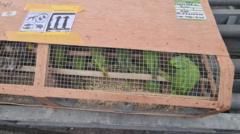The Museum Boijmans Van Beuningen in Rotterdam announced that a child has inadvertently scratched the surface of Mark Rothko’s painting Grey, Orange on Maroon, No. 8 during an unguarded moment. Efforts are underway to assess the damage and determine restoration options as the gallery considers liability issues.
Child Accidentally Damages Priceless Rothko Painting in Rotterdam Museum

Child Accidentally Damages Priceless Rothko Painting in Rotterdam Museum
A young child has caused superficial damage to a €50 million Rothko artwork at the Museum Boijmans Van Beuningen, raising questions about art conservation and liability.
In a recent incident that has stirred the art world, a child inadvertently damaged a painting valued at €50 million ($53 million) by renowned American artist Mark Rothko at the Museum Boijmans Van Beuningen in Rotterdam. According to museum representatives, the damage occurred during a brief moment when the painting was not being closely monitored, as reported by Algemeen Dagblad and confirmed by the BBC.
The museum spokesperson characterized the damage as "superficial," emphasizing that the scratches appeared in the lower section of the painting's unvarnished paint layer. Experts are currently assessing the situation, with conservation specialists from the Netherlands and beyond being consulted to explore the best future treatment options for this iconic piece of abstract art.
Sophie McAloone, a conservation manager at the Fine Art Restoration Company, highlighted that modern unvarnished paintings, especially those like Rothko's, are notably vulnerable to damage. The combination of complex materials used in their creation, a lack of traditional protective coatings, and the visual prominence of damage make even small scratches quite noticeable. McAloone mentioned that the scratches could significantly affect the viewer's experience of the artwork.
The painting was on display at the museum's Depot, which serves as a publicly accessible storage facility alongside the main museum, showcasing fan-favorite selections from the gallery's collection. This recent incident may carry implications for other institutions, particularly in the UK, as they consider opening their archives for public display. Jonny Helm from the art restoration service Plowden & Smith expressed concerns regarding how this damage might influence policies at museums like the V&A East and the British Museum, which are exploring similar initiatives.
The restoration process for the Rothko painting is expected to be intricate, given the complexities involved in Rothko's unique materials and his signature techniques. Conservators will need to document the extent of the damage, possibly referring to historic restoration methods used for Rothko artworks in the past. Notably, this is not the first time Rothko's works have faced vandalism; his 1958 piece Black on Maroon was intentionally damaged at London's Tate Modern in 2012.
Insurance considerations also play a key role in this scenario. Rachel Myrtle, from Aon insurance, explained that standard fine art insurance policies generally cover incidents of accidental damage, including those caused by children or visitors. In such cases, an insurance adjuster typically evaluates the damages, reviews evidence such as CCTV footage, and explores conservation strategies.
While the museum has not disclosed who will bear responsibility for the damage, it has a history of holding individuals accountable for damaging art in its collection. In a previous incident in 2011, the museum requested payment from a tourist for repairs after the visitor inadvertently stepped on a work of art.
Rothko’s Grey, Orange on Maroon, No. 8 is emblematic of color field painting, characterized by large expanses of flat colors on canvas. The damaged artwork is one among a number of modern art pieces that have encountered issues in the Netherlands recently, including incidents involving works by pop artist Andy Warhol.
Responses to art-related accidents vary widely among museums, as demonstrated by a similar occurrence at the Hecht Museum in Israel last year, where a four-year-old child accidentally shattered a priceless artifact. In that case, the museum chose a lenient approach, inviting the family back for a guided tour as a means of fostering positive engagement despite the unfortunate incident.




















